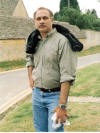|
|
the-south-asian.com July / August 2006 |
|
|||
|
August/September Contents
Sufis - wisdom against 50
years of mountain Heritage cities:
Cotton - the fibre of
|
|
||||
|
Page
3 of 3 BASANT - 'A sky without frontiers' - the Spring Festival of Kites (Cntd) by Salman Minhas
First published in March 2002
Kite Fighting is an integral part of the Basant Kite festival. The sport has evolved into a fine art with techniques probably introduced to South Asia by the Chinese who were the first to use kites around 300 B.C. as part of military signaling warfare.
Fighter kites : These come in different shapes and sizes and names - Gudda [ the male, normally the heavier fighter kite ] , Guddi [ the female kite], Patang, Tukkal, Chagg, Pari, Do-Akhal , Lepo , Rocket, Parphara- are just some of the different types of fighter kites from India & Pakistan. Kites are made traditionally from rice paper [tracing paper] of various thickness. Rice paper kites originated in China & Japan. These days people in South Asia are beginning to experiment with newer materials such as Nylon, Teflon, Orcon, Icarex or Mylar . The kite spines & bows are traditionally made from Bamboo strip. However, with western countries participating in south Asian kite fighting festivals, new materials for kite-spines /bows have been introduced such as graphite, carbon, etc. The Thread or Line [ Dori ] The line or thread is specially prepared with a paste called "Manjha" [In France there is a Kite Fighters Club by the name of Manjha International Club]. Manjha is a secret paste made from eggs [to provide the stickiness], wet flour or boiled rice as glue, finely ground glass, glue, color, and a few other ingredients. Normally prior to the Basant festival, one can often see this thread for kite fighting being prepared on the streets around Lahore or Ahmedabad - the two major kite fighting or Basant centers in South Asia. The thread is a weave of nine threads of cotton line; varieties of names exist - there is a Number 30 [ tees number] which is a six thread weave, or Number 10 [ Das number a thicker variety.] The Tangle or "Pecha":
Manjha - glass-coated
line being prepared carefully Fighting Kites involves a tangle with the lines, which are controlled by the kite fliers. The line is called "Dori" which has been applied with the "Manjha" and as such is very sharp and can cut another line or dori. It can also result in cuts to the fingers and hence kite fighting involves protecting your fingers carefully. The origin of the word Dori is curious ; it may have had its origins from the Portuguese word "bidoro" for glass. In Indonesia there is a similar word for the kite line/ thread. The Portuguese traders may have brought the kite fighting sport to Japan via Indonesia from India and the Japanese fighter kites [ the Hata or the Buka] look very similar in design to the India Gudda Kite. The dori is usually wound over paper balls and another person usually assists in winding or releasing the dori. In India and Bangla Desh, kite fliers also use a spool [ called charkhi in India & Pakistan and natai in Bengali] made from wood or bamboo to roll the dori. The Pecha involves a series of "pulls" or "releases" of the line flying the kite. As the kite weaves and dives and serenades in the blue sky the lines are busy cutting each other until finally the stronger line cuts the other kiteís line . This is the moment when the shouts of "Bo-Kata" or "Woh-Kata" literally meaning "there itís cut ..." or "knock-out" . Kite Looting: [ Mr. Lutiara ] Once the kite is cut, there is a free-for-all chase of looting the kite that is cut [this is called "guddi lootna" . It involves carefree urchins running into the streets , or on roof -tops armed with bamboo or a stone attached to the dore. The idea is to grab the trailing kite line that is floating downwards to the ground from the sky. In Lahore the more desperate kids will use steel wire to get at kites that are cut . The result is frequent [1500 power cuts on a peak day] electricity power breakdowns over all parts of the city. There is an award called Mr. Lutiara given to a person who loots the most kites.
_________________________
|
|||||
|
Copyright © 2000 - 2006 [the-south-asian.com]. Intellectual Property. All rights reserved. |
|||||







